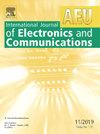A high linearity and low-noise potentiostat with current Mirror, chopper stabilization and relaxation circuit techniques for implantable sensor applications
IF 3
3区 计算机科学
Q2 ENGINEERING, ELECTRICAL & ELECTRONIC
Aeu-International Journal of Electronics and Communications
Pub Date : 2025-03-08
DOI:10.1016/j.aeue.2025.155762
引用次数: 0
Abstract
This work proposes a potentiostat design with low noise, high linearity, and low power consumption capabilities for implantable biomedical sensor applications. This work is novel in that it combines three techniques: a current mirror-based topology, a chopper stabilization, and a relaxation circuit. All circuits in the design operate on 0.13 μm standard CMOS technology, utilizing a single 1.2 V power supply. The current mirror-based potentiostat mirrors the current to the frequency converter in an RC relaxation oscillator. The period between pulses inversely affects current. Using simulation software, the current was adjusted from 29.8nA to 2.83μA, inversely proportional to altering the working electrode resistance from 100kΩ to 10MΩ. Output frequencies ranged from 470.10 kHz to 27.43 MHz. The simulated results revealed that the mirrored sensing current was accurate with a 0.02 % deviation. The chopper stabilization was combined to regulate the potential using a negative feedback loop that was able to decrease noise by about 18.20 % at the observed frequency of 1 Hz. It was minimized at low frequency while the system stability increased. The overall power consumption of all circuits was less than 42.56 µW. As a result, this designed potentiostat is a promising candidate for implantable sensor applications.
一个高线性和低噪声的恒电位器,具有电流镜,斩波稳定和松弛电路技术,用于植入式传感器应用
这项工作提出了一种具有低噪声,高线性度和低功耗能力的植入式生物医学传感器的恒电位器设计。这项工作的新颖之处在于它结合了三种技术:基于电流镜像的拓扑结构,斩波稳定和松弛电路。设计中的所有电路都采用0.13 μm标准CMOS技术,使用单个1.2 V电源。基于电流镜的恒电位器将电流反射到RC弛豫振荡器中的变频器。脉冲之间的周期与电流相反。通过仿真软件,将电流从29.8nA调整到2.83μA,与工作电极电阻从100kΩ改变到10MΩ成反比。输出频率范围从470.10 kHz到27.43 MHz。仿真结果表明,镜像传感电流精度为0.02%。斩波稳定结合使用负反馈回路来调节电位,在观测频率为1hz时,能够将噪声降低约18.20%。当系统稳定性提高时,其在低频时被最小化。所有电路的总功耗均小于42.56µW。因此,这种设计的恒电位器是一种很有前途的植入式传感器应用。
本文章由计算机程序翻译,如有差异,请以英文原文为准。
求助全文
约1分钟内获得全文
求助全文
来源期刊
CiteScore
6.90
自引率
18.80%
发文量
292
审稿时长
4.9 months
期刊介绍:
AEÜ is an international scientific journal which publishes both original works and invited tutorials. The journal''s scope covers all aspects of theory and design of circuits, systems and devices for electronics, signal processing, and communication, including:
signal and system theory, digital signal processing
network theory and circuit design
information theory, communication theory and techniques, modulation, source and channel coding
switching theory and techniques, communication protocols
optical communications
microwave theory and techniques, radar, sonar
antennas, wave propagation
AEÜ publishes full papers and letters with very short turn around time but a high standard review process. Review cycles are typically finished within twelve weeks by application of modern electronic communication facilities.

 求助内容:
求助内容: 应助结果提醒方式:
应助结果提醒方式:


